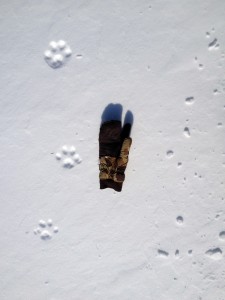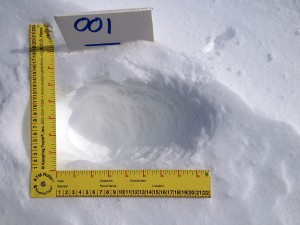January 6, 2016 at 2:39 pm
A Field Report from the Rangeley Lakes Region by Regional Wildlife Biologist Chuck Hulsey
Last year we had a winter with more snow, cold, and wind than usual. It was also a winter where conducting lynx track surveys was a priority for regional wildlife biologists stationed in northern, western, and eastern Maine. With survey protocol and locations provided by IFW lynx biologist Jen Vashon, our goal in Region D was to conduct five township-wide track surveys to assess the abundance and distribution of lynx.
 In order to be accurate, these track surveys had to be run during a 48-hour window, one that started 24 hours after the end of a snow storm or significant winds. During that time frame, we had to survey 55-80 kilometers (33-48 miles), and if it wasn’t totally completed, we had to start from the beginning another time. The reason for the time frame was to standardize the amount of time animals could run around leaving tracks in fresh snow. We also took advantage of the opportunity to assess the abundance of snowshoe hare and bobcat, the former being the prime food source for lynx as well as the soup du jour for many other predators.
The survey included driving a snowmobile on a predetermined route and stopping every time you encountered a lynx track.
While a survey route could be run on a plowed dirt road if the snowbanks were not too hard to see over, riding snowmobiles on unplowed roads or trails was the way we amassed most of our survey miles. Upon encountering tracks we’d collect a GPS waypoint and multiple track measurements to include length, width, stride, and straddle (see image). We would also document direction of travel as well as forest habitat type.
Fellow regional wildlife biologist Bob Cordes and I surveyed Township C, Carrying Place Town Township, and Chase Stream Township, and encountered lynx tracks in two of the three. Chase Stream Township was memorable in that it was a balmy minus 25 degrees when we started. With help from regional wildlife biologists Scott Lindsay and Cory Stearns (Region A-Gray) and Kendall Marden (Region B-Sidney), we wrapped up the winter’s lynx work with surveys in Lynchtown and Parmachenee Townships. For those, we enjoyed a group overnight at the Warden Camp near Parmachenee Lake.
In order to be accurate, these track surveys had to be run during a 48-hour window, one that started 24 hours after the end of a snow storm or significant winds. During that time frame, we had to survey 55-80 kilometers (33-48 miles), and if it wasn’t totally completed, we had to start from the beginning another time. The reason for the time frame was to standardize the amount of time animals could run around leaving tracks in fresh snow. We also took advantage of the opportunity to assess the abundance of snowshoe hare and bobcat, the former being the prime food source for lynx as well as the soup du jour for many other predators.
The survey included driving a snowmobile on a predetermined route and stopping every time you encountered a lynx track.
While a survey route could be run on a plowed dirt road if the snowbanks were not too hard to see over, riding snowmobiles on unplowed roads or trails was the way we amassed most of our survey miles. Upon encountering tracks we’d collect a GPS waypoint and multiple track measurements to include length, width, stride, and straddle (see image). We would also document direction of travel as well as forest habitat type.
Fellow regional wildlife biologist Bob Cordes and I surveyed Township C, Carrying Place Town Township, and Chase Stream Township, and encountered lynx tracks in two of the three. Chase Stream Township was memorable in that it was a balmy minus 25 degrees when we started. With help from regional wildlife biologists Scott Lindsay and Cory Stearns (Region A-Gray) and Kendall Marden (Region B-Sidney), we wrapped up the winter’s lynx work with surveys in Lynchtown and Parmachenee Townships. For those, we enjoyed a group overnight at the Warden Camp near Parmachenee Lake.
 To get an idea of how much snow that country gets, we ran our final route on the first day of spring. After a lunch break with Scott and Cory, I buried my sled when turning around in a young clearcut. When I stepped off the sled I sank in chest-deep powder snow and I’m 6-4. That alone shows how well designed a lynx is to live and succeed in the north country. We came across a couple dozen lynx tracks those two days (many the same cat) and none sank more than eight inches, and most usually less.
[embed]https://youtu.be/J47Ez12mtgM?list=PLPbLPUhTMHuuTmmkiMr7uISD8anJoRZVn[/embed]
To get an idea of how much snow that country gets, we ran our final route on the first day of spring. After a lunch break with Scott and Cory, I buried my sled when turning around in a young clearcut. When I stepped off the sled I sank in chest-deep powder snow and I’m 6-4. That alone shows how well designed a lynx is to live and succeed in the north country. We came across a couple dozen lynx tracks those two days (many the same cat) and none sank more than eight inches, and most usually less.
[embed]https://youtu.be/J47Ez12mtgM?list=PLPbLPUhTMHuuTmmkiMr7uISD8anJoRZVn[/embed]
 In order to be accurate, these track surveys had to be run during a 48-hour window, one that started 24 hours after the end of a snow storm or significant winds. During that time frame, we had to survey 55-80 kilometers (33-48 miles), and if it wasn’t totally completed, we had to start from the beginning another time. The reason for the time frame was to standardize the amount of time animals could run around leaving tracks in fresh snow. We also took advantage of the opportunity to assess the abundance of snowshoe hare and bobcat, the former being the prime food source for lynx as well as the soup du jour for many other predators.
The survey included driving a snowmobile on a predetermined route and stopping every time you encountered a lynx track.
While a survey route could be run on a plowed dirt road if the snowbanks were not too hard to see over, riding snowmobiles on unplowed roads or trails was the way we amassed most of our survey miles. Upon encountering tracks we’d collect a GPS waypoint and multiple track measurements to include length, width, stride, and straddle (see image). We would also document direction of travel as well as forest habitat type.
Fellow regional wildlife biologist Bob Cordes and I surveyed Township C, Carrying Place Town Township, and Chase Stream Township, and encountered lynx tracks in two of the three. Chase Stream Township was memorable in that it was a balmy minus 25 degrees when we started. With help from regional wildlife biologists Scott Lindsay and Cory Stearns (Region A-Gray) and Kendall Marden (Region B-Sidney), we wrapped up the winter’s lynx work with surveys in Lynchtown and Parmachenee Townships. For those, we enjoyed a group overnight at the Warden Camp near Parmachenee Lake.
In order to be accurate, these track surveys had to be run during a 48-hour window, one that started 24 hours after the end of a snow storm or significant winds. During that time frame, we had to survey 55-80 kilometers (33-48 miles), and if it wasn’t totally completed, we had to start from the beginning another time. The reason for the time frame was to standardize the amount of time animals could run around leaving tracks in fresh snow. We also took advantage of the opportunity to assess the abundance of snowshoe hare and bobcat, the former being the prime food source for lynx as well as the soup du jour for many other predators.
The survey included driving a snowmobile on a predetermined route and stopping every time you encountered a lynx track.
While a survey route could be run on a plowed dirt road if the snowbanks were not too hard to see over, riding snowmobiles on unplowed roads or trails was the way we amassed most of our survey miles. Upon encountering tracks we’d collect a GPS waypoint and multiple track measurements to include length, width, stride, and straddle (see image). We would also document direction of travel as well as forest habitat type.
Fellow regional wildlife biologist Bob Cordes and I surveyed Township C, Carrying Place Town Township, and Chase Stream Township, and encountered lynx tracks in two of the three. Chase Stream Township was memorable in that it was a balmy minus 25 degrees when we started. With help from regional wildlife biologists Scott Lindsay and Cory Stearns (Region A-Gray) and Kendall Marden (Region B-Sidney), we wrapped up the winter’s lynx work with surveys in Lynchtown and Parmachenee Townships. For those, we enjoyed a group overnight at the Warden Camp near Parmachenee Lake.
 To get an idea of how much snow that country gets, we ran our final route on the first day of spring. After a lunch break with Scott and Cory, I buried my sled when turning around in a young clearcut. When I stepped off the sled I sank in chest-deep powder snow and I’m 6-4. That alone shows how well designed a lynx is to live and succeed in the north country. We came across a couple dozen lynx tracks those two days (many the same cat) and none sank more than eight inches, and most usually less.
[embed]https://youtu.be/J47Ez12mtgM?list=PLPbLPUhTMHuuTmmkiMr7uISD8anJoRZVn[/embed]
To get an idea of how much snow that country gets, we ran our final route on the first day of spring. After a lunch break with Scott and Cory, I buried my sled when turning around in a young clearcut. When I stepped off the sled I sank in chest-deep powder snow and I’m 6-4. That alone shows how well designed a lynx is to live and succeed in the north country. We came across a couple dozen lynx tracks those two days (many the same cat) and none sank more than eight inches, and most usually less.
[embed]https://youtu.be/J47Ez12mtgM?list=PLPbLPUhTMHuuTmmkiMr7uISD8anJoRZVn[/embed]